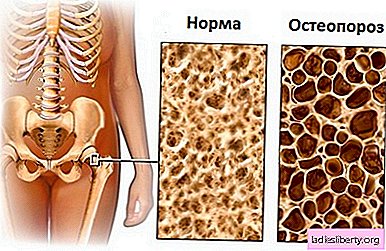
Osteoporosis - a disease in which a person’s bone tissue loses its strength and becomes fragile, as a result of which the patient’s bones can break quite often. Bone mass is lost slowly and asymptomatically, which greatly complicates the detection of osteoporosis in the early stages.
According to the World Health Organization, osteoporosis ranks 4th in terms of prevalence among noncommunicable diseases. This disease is the main cause of a femoral neck fracture, which is often found in patients over 60 years of age. In terms of socio-economic importance, osteoporosis has become a big problem all over the world.
Osteoporosis - Causes
As a person ages, a decrease in the density of his bones, as well as a decrease in their strength. This is a completely normal physiological process. But for some people, for several reasons, these changes may occur earlier and occur more intensively.
Factors that can lead to the development of osteoporosis:
- deficiency of calcium and vitamin D;
- the use of a number of drugs (anticonvulsants and corticosteroids);
- sedentary lifestyle;
- systematic smoking and drinking;
- heredity.
Osteoporosis - Symptoms
Osteoporosis is characterized by extremely meager symptoms. Often, the disease manifests itself only in the presence of fractures. “Silent epidemic of the 20th century” - this is the name given to osteoporosis by scientists.
However, there are a number of indirect symptoms of the disease. First of all, it is aching back pain, which manifests itself with a long stay of a person (more than 30 minutes) in a static pose. In addition, the presence of osteoporosis can be indicated by senile stoop (the so-called hump), increased fatigue, night leg cramps, brittle nails, periodontal disease, early graying.
Osteoporosis - diagnosis
First of all, if osteoporosis is suspected, an x-ray of the spine is necessary. This study is simple and affordable, but it has an important minus - in the picture, osteoprosis can be diagnosed only when 20-30% of the bone mass is lost. In addition, the interpretation of the image largely depends on the qualifications of the doctor.
A more accurate diagnosis is carried out using a densitometer - an apparatus for measuring bone density. Using densitometry, the density is determined with an error of only 1 - 5%. The main disadvantage of this type of diagnosis is the high cost.
For the selection of medicines, a biochemical blood test is necessary, which will establish the content in the patient's blood of calcium, phosphorus and a number of other substances.
Osteoporosis - treatment and prevention
Methods of treating osteoporosis are divided into 2 groups that complement each other remarkably: drug therapy and a healthy lifestyle, which involves moderate physical activity, sun exposure and massage.
With regular exercises in therapeutic gymnastics, after a few months, bone mass growth is 3 - 5%. However, it is very important that the set of exercises is compiled individually.
Vacuum and manual massage significantly enhance the effect of gymnastics. These procedures can significantly improve blood circulation, as well as “pump” back muscles. However, the massage should be gentle.
Staying in the sun and moderate tanning allows the body to synthesize vitamin D, which helps build bone mass. However, do not forget about the dangers of sunburn, especially in old age. In the case of using this method of treatment, it is better to consult a dermatologist.
Prevention of osteoporosis comes down to maintaining a healthy lifestyle.











